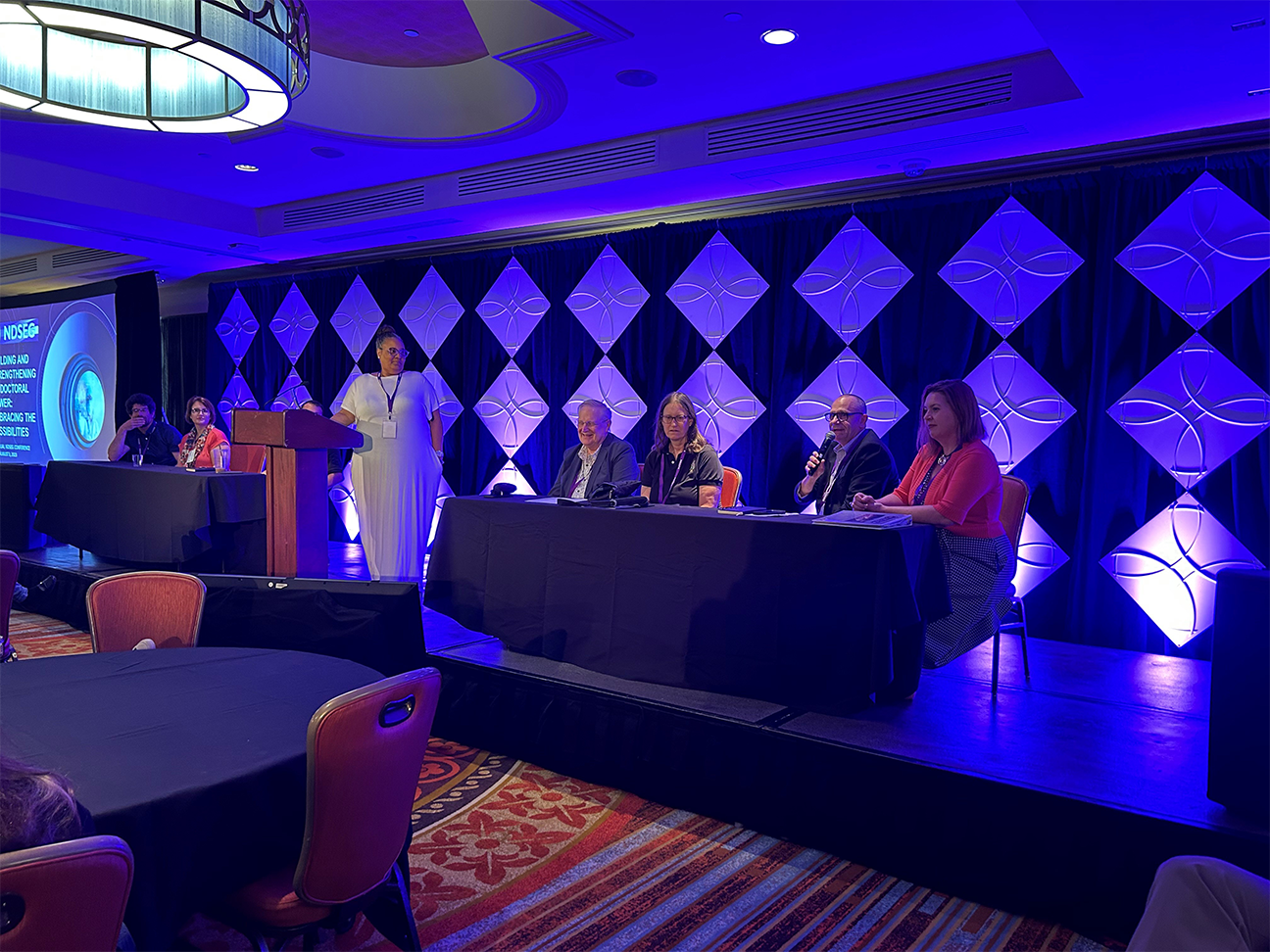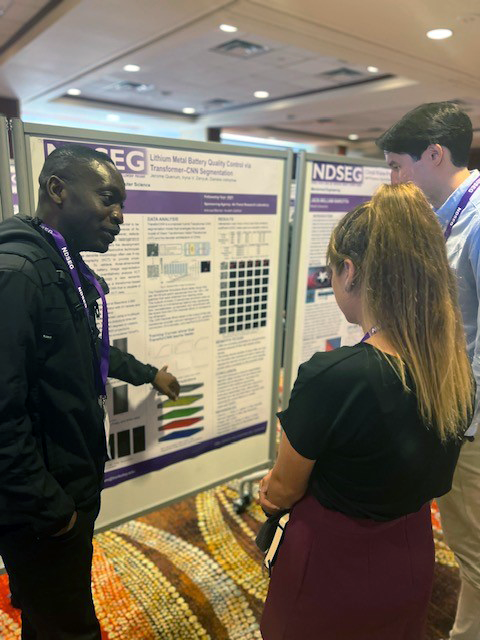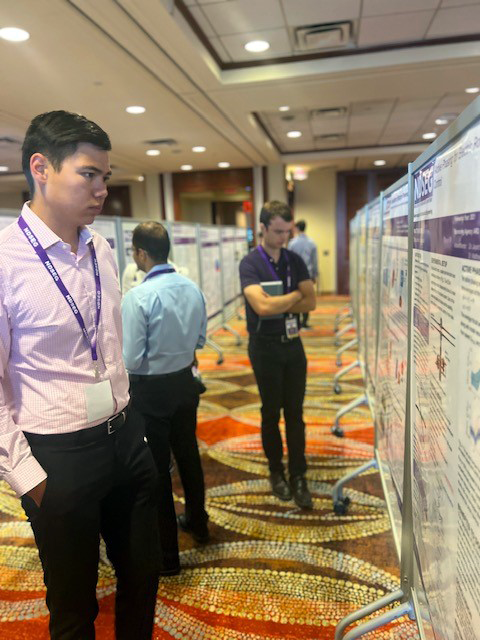WRIGHT-PATTERSON AIR FORCE BASE, Ohio (AFRL) – The Air Force Research Laboratory’s, or AFRL, Air Force Office of Scientific Research, or AFOSR, hosted a STEM-focused conference July 31 to Aug. 3, 2023, for the Department of Defense National Defense Science and Engineering Graduate Fellowship program, or NDSEG, at the Hilton Palacio del Rio in San Antonio, Texas.
The conference featured various speakers and talks from DOD national leaders and subject matter experts in the fields of science, technology and engineering that showcased ongoing research activities relevant to the national defense mission for the class of 2021 NDSEG fellows who attended from across the country. The fellows had the chance to participate in research presentations, workshops, a career fair and connect with like-minded researchers and scientists.

Ellen Robinson, standing, program coordinator, National Defense Science and Engineering Graduate Fellowship, or NDSEG; and Dr. Timothy Bunning, second from right, chief technology officer, Air Force Research Laboratory, along with Air Force and Space Force science and technology leaders, offer post-doctoral students early career advice at the fourth annual NDSEG conference at the Hilton Palacio del Rio in San Antonio, Texas, July 30, 2023. The NDSEG class of 2023 fellows had the opportunity to hear from NDSEG mentors and subject matter experts during panels and breakout sessions. (U.S. Air Force photo / Aleah M. Castrejon)
Dr. Timothy J. Bunning, chief technology officer and former fellow, AFRL, expressed the importance of NDSEG as a pipeline of future talent in science and engineering career fields.
“The DOD invests a lot of money in the NDSEG awardees every year,” Bunning said. “I think it’s beneficial for them to come together and for them to realize they’re part of a community that can work with each other and probably build friendships that will last through their career.”
The fellows are now part of the defense ecosystem, whether they choose academia, industry or government, Bunning added. In addition to students learning about available opportunities within the community, as they continue their education, Bunning said building a network and learning to collaborate are just as important.

Jerome Quenum, a fellow with Air Force Research Laboratory’s, or AFRL, Air Force Office of Scientific Research, or AFOSR, presents his research in computer science with his peers at the poster exhibit hall Aug. 1, 2023, during the National Defense Science and Engineering Graduate Fellowship, or NDSEG, at the Hilton Palacio del Rio in San Antonio, Texas. NDSEG fellows presented their work to DOD evaluators, peers and mentors, and discussed the research conducted during their fellowship. (U.S. Air Force photo / Brianna Hodges)
Bunning urged the students to build relationships in their classes, as academia is an individual activity, whereas the real world is about working in multi-disciplinary teams, who don’t necessarily speak the same language as their classmates.
Bunning highly recommended the fellows experience the laboratories.
Dr. William “Pat” Roach, chief scientist, AFOSR, explained other funding opportunities and educational programs and echoed Bunning’s sentiments in urging the fellows to visit the laboratories.
“Come and have the opportunity to work in a world-class laboratory with world-class resources,” Roach said.
During a panel discussion, Roach spoke about AFRL’s national and international portfolios.
“How we do our mission is really important. We look for qualified, responsible organizational applicants from academia, primarily,” he said. “But the one thing that we cherish more than anything else is a wild idea that no one else has thought about.”
Roach encouraged the fellows to push their new ideas forward by submitting proposals.
“One of the things that we’re good about doing is funding young men and women at the beginning of their academic career in the young investigator program,” Roach added.
And while there are pros and cons to an academic career, an industrial career and a DOD career, Bunning explained that a career with the DOD is team oriented and incorporates more opportunities.
“There are many opportunities to reinvent yourselves through the years, and depending on the lab that you go to, I would say you’re typically much more capable of building a career than identity in a technical community, a peer community,” Bunning said. “If you want to be part of a larger peer community, I’d say the DOD career statistically opens more doors to allow you to do that than an industrial career.”
The Air Force, Army, Navy, and Space Force have world class materials, Bunning said, but they are working on slightly different paths, as Heidi Shyu, chief technology officer, undersecretary of defense for research and engineering, DOD, explained in her opening speech.

Dr. Timothy Bunning, chief technology officer, Air Force Research Laboratory, or AFRL, kicks off the National Defense Science and Engineering Graduate Fellowship, or NDSEG, conference for the Department of Air Force with opening remarks at the Hilton Palacio del Rio in San Antonio, Texas, July 31, 2023. Bunning talked to the NDSEG Fellows about career and fellowship opportunities available within AFRL. (U.S. Air Force photo / Brianna Hodges)
“There is a thing called the ‘line 21’, which really pulls the three services together under these communities of interest to make sure that we’re not duplicating efforts and that we are all working, or rowing, in the same direction – with respect to the networks,” Bunning said.
In her role, Shyu is responsible for ensuring the technological edge of the U.S. military, now and into the future.
“Earlier this year, I released the National Defense Science and Technology Strategy. In this document, we laid out the path to address the emerging threats of this era of strategic competition.”
The plan, anchored by three pillars, includes a focus on the joint mission of establishing rigorous processes to inform decision making in a resource constrained environment, training and fielding capabilities at speed and scale, and showing the foundations for research and development.
“This last pillar is where you all come in, the duty recognizes the importance of funding early-stage research that may yield transformative impact on the battle in space for decades to come,” Shyu said. “Just as important, we recognize how critical it is to build pipelines to ensure we have access to the best talent our nation has to offer.”
While there are many fellowship and grant programs for universities, Shyu said, “NDSEG is the crown jewel of our university partnership.”
American universities are tackling some of the DOD’s biggest technical challenges, such as microelectronics, AI, biotech, quantum science and advanced materials, Shyu said.
Shyu encouraged the fellows to consider a career in the defense innovation enterprise.
“At the DOD, we offer our STEM professionals the opportunity to tackle some of the world’s toughest technical questions, to work alongside the world’s best problem solvers and to help build the world’s most state-of-the-art systems,” she added.

National Defense Science and Engineering Graduate Fellowship, or NDSEG, fellows review their classmates’ posters in different disciplines at the poster exhibit hall Aug. 1, 2023, at the Hilton Palacio del Rio in San Antonio, Texas. The NDSEG class of 2023 fellows displayed their research findings for DOD evaluators, peers and mentors in the science and technology community. (U.S. Air Force photo / Brianna Hodges)
She also highlighted the ability of STEM professionals to work on and have a real-world impact with the DOD.
“Our scientists, technologists and engineers are not looking to maximize profit,” she said. “They’re working on life-or-death problems with the lives of our troops hanging in the balance. It is a tremendous responsibility, but one that our STEM professionals are proud to take on. We are living in unstable times, the threats we face are grave. More than ever, it is clear to all that a stronger America is a better world. To succeed, our nation needs the brightest minds to take in the hardest technical challenges. That’s why we need NDSEG students.”
About AFRL
The Air Force Research Laboratory is the primary scientific research and development center for the Department of the Air Force. AFRL plays an integral role in leading the discovery, development and integration of affordable warfighting technologies for our air, space and cyberspace force. With a workforce of more than 11,500 across nine technology areas and 40 other operations across the globe, AFRL provides a diverse portfolio of science and technology ranging from fundamental to advanced research and technology development. For more information, visit www.afresearchlab.com.
About NDSEG
NDSEG is a joint service university research initiative, or URI, which was established in 1989 by direction of congress as an approach to increasing the number of U.S. citizens receiving doctoral degrees in science and engineering disciplines to DOD relevance. This program is currently supported by the Air Force Office of Scientific Research, or AFOSR, the Army Research Office, or ARO, and the Office of Naval Research, or ONR, and the United States Space Force, or USSF, under the direction of the Office of the Under Secretary of Defense for Research & Engineering. For more information, visit https://ndseg.vfairs.com/.

